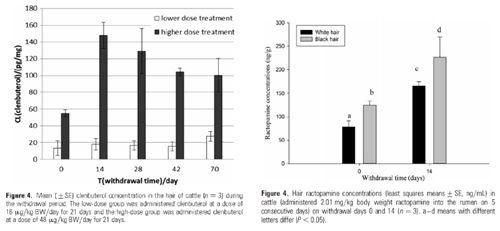分享到
Hair samples can be used as target for monitoring β-adrenergic agonist abuse in cattle
Recently, Prof. Junmin Zhang’s team in the Institute of Animal Science (IAS) of Chinese Academy of Agricultural Sciences (CAAS) has made a new progress in monitoring β-adrenergic agonist abuse in cattle. The research results revealed that hair had higher potential for accumulation of β-adrenergic agonist residues than urine or plasma, and hair samples could be used as the target matrix to monitor their illegal use. The research paper entitled Accumulation of Clenbuterol Residues in the Hair of Chinese Simmental Beef Cattle During and After Treatment has been published on the first issue of Journal of Analytical Toxicology of 2014.
The use of β-adrenergic agonist in animals has been banned in many countries. However, food poisoning events happened occasionally around the world by consumption of β-adrenergic agonist (such as clenbuterol and ractopamine) contaminated animal products. Normally urine and plasma samples were collected for routine surveillance by supervisory authority. However, negative results for β-adrenergic agonists in urine and plasma during the later withdrawal period would be obtained, which does not mean that the concentrations in edible tissues are lower than the maximum residue limits. Their study demonstrated the rapid elimination of β-adrenergic agonist in urine and plasma in cattle, while accumulation of β-adrenergic agonist in cattle’s hair is high and persistent. The residues of clenbuterol in cattle’s white hair were still detectable on withdrawal day 70, and even longer in the red hair. Although the ability of binding to melanin of ractopamine is weaker than clenbuterol, hair is still an optimal target matrix among other living samples. After being treated with ractopamine for five days, the residues of ractopamine in cattle’s black and white hair were 226.7 ng/g and 165.6 ng/g on withdrawal day 14, respectively, which were higher than those in urine (8.3 ng/mL) and plasma (below the limits of quantification=0.2 ng/mL). Meanwhile, we made an improvement on the hair pretreatment procedure by using a liquid nitrogen grinding method with a ball mill to guarantee the accuracy of sample detection.

All the results indicated that hair matrix could be used as a target matrix to monitor β-adrenergic agonist abuse in cattle.
http://jat.oxfordjournals.org/content/38/1/52.short
http://jat.oxfordjournals.org/content/38/3/149
The use of β-adrenergic agonist in animals has been banned in many countries. However, food poisoning events happened occasionally around the world by consumption of β-adrenergic agonist (such as clenbuterol and ractopamine) contaminated animal products. Normally urine and plasma samples were collected for routine surveillance by supervisory authority. However, negative results for β-adrenergic agonists in urine and plasma during the later withdrawal period would be obtained, which does not mean that the concentrations in edible tissues are lower than the maximum residue limits. Their study demonstrated the rapid elimination of β-adrenergic agonist in urine and plasma in cattle, while accumulation of β-adrenergic agonist in cattle’s hair is high and persistent. The residues of clenbuterol in cattle’s white hair were still detectable on withdrawal day 70, and even longer in the red hair. Although the ability of binding to melanin of ractopamine is weaker than clenbuterol, hair is still an optimal target matrix among other living samples. After being treated with ractopamine for five days, the residues of ractopamine in cattle’s black and white hair were 226.7 ng/g and 165.6 ng/g on withdrawal day 14, respectively, which were higher than those in urine (8.3 ng/mL) and plasma (below the limits of quantification=0.2 ng/mL). Meanwhile, we made an improvement on the hair pretreatment procedure by using a liquid nitrogen grinding method with a ball mill to guarantee the accuracy of sample detection.

All the results indicated that hair matrix could be used as a target matrix to monitor β-adrenergic agonist abuse in cattle.
http://jat.oxfordjournals.org/content/38/1/52.short
http://jat.oxfordjournals.org/content/38/3/149
By Wu Zhenkun
ias@caas.cn
ias@caas.cn
Latest News
-
 Apr 18, 2024Opening Ceremony of the Training Workshop on Wheat Head Scab Resistance Breeding and Pest Control in Africa Held in CAAS
Apr 18, 2024Opening Ceremony of the Training Workshop on Wheat Head Scab Resistance Breeding and Pest Control in Africa Held in CAAS -
 Apr 03, 2024IPPCAAS Co-organized the Training Workshop on Management and Application of Biopesticides in Nepal
Apr 03, 2024IPPCAAS Co-organized the Training Workshop on Management and Application of Biopesticides in Nepal -
 Mar 28, 2024Delegation from the School of Agriculture and Food Science of University College Dublin, Ireland Visit to IAS, CAAS
Mar 28, 2024Delegation from the School of Agriculture and Food Science of University College Dublin, Ireland Visit to IAS, CAAS -
 Mar 25, 2024Director of World Food Prize Foundation visited GSCAAS
Mar 25, 2024Director of World Food Prize Foundation visited GSCAAS -
 Mar 20, 2024Institute of Crop Sciences (ICS) and Syngenta Group Global Seeds Advance Collaborative Research in the Seed Industry
Mar 20, 2024Institute of Crop Sciences (ICS) and Syngenta Group Global Seeds Advance Collaborative Research in the Seed Industry
